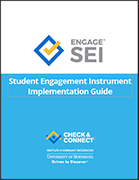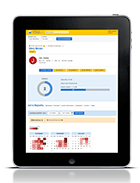

Main navigation | Main content
The Student Engagement Instrument (SEI) is a brief 35 item self-reporting survey measuring cognitive and affective engagement and is validated for students in 6th through 12th grade. Data allows school professionals to gain insights into a student’s sense of control, intrinsic motivation, and future aspirations (cognitive engagement factors). Support teams working with students will also have a better understanding of a student’s relationships with teachers, peers, and family support (affective engagement factors).
The SEI-E measures the same three affective engagement factors as the original SEI. The Student Engagement Instrument (SEI-E) has 33 questions and is validated for students in 3rd through 5th grade. However, for cognitive engagement, the SEI-E measures only future aspirations and intrinsic motivation.
Disengagement starts long before academic and behavioral indicators signal a need for intervention. The SEI will allow schools to increase effectiveness of early identification processes. For those students who are already showing signs of disengagement, combining SEI data with academic and behavioral data will help staff provide targeted engagement interventions.

The SEI is currently available in pencil/paper form.

SEI measures what students think and feel about school. SEI—
The SEI and SEI - E are utilized by
The SEI is based on a model of engagement that grew out of work with Check & Connect. Check & Connect mentors recognized that successfully re-engaging students required more than meeting academic and behavioral standards of schools. Rather, successful engagement also required attention to students’ cognitive (e.g., self-regulation, perceived relevance of schooling, future goals) and affective engagement (e.g., belonging, relationships with teachers and peers) at school and with learning. Christenson and colleagues proposed a 4-part typology of engagement that included academic, behavioral, cognitive, and affective subtypes (Appleton, Christenson, Kim, & Reschly, 2006; Christenson & Anderson, 2002; Christenson et al., 2008; Reschly & Christenson, 2006). Indicators of students’ academic and behavioral engagement are typically readily available in school data systems; however, affective and cognitive engagement require student self-report.
| Observable, Low Inference Subtypes | High Inference, Internal Subtypes |
|---|---|
| Example Indicators | Example Indicators |
Academic
|
Affective
|
Behavioral
|
Cognitive
|
Adapted from Reschly, Appleton, and Christenson, 2007; Reschly, Pohl, & Appleton, 2014;
The SEI is free to use for research or practice purposes. You may not use it for purposes resulting in profit.
The 5-point scale includes “Neither Agree nor Disagree” answer choice which the 4-point scale does not. Use whichever version best meets your site's needs.
Appleton, J. J. (2012). Systems consultation: Developing the assessment-to-intervention link with the Student Engagement Instrument. In S. L. Christenson, A. L. Reschly, and C. Wylie (Eds.), Handbook of research on student engagement (pp. 725-741). New York, NY: Springer Science.
Appleton, J. J., Christenson, S. L., Kim, D., & Reschly, A. L. (2006). Measuring cognitive and psychological engagement: Validation of the Student Engagement Instrument. Journal of School Psychology, 44, 427–445. doi: 10.1016/j/jsp.2006.04.002
Carter, C. P., Reschly, A. L., Lovelace, M. D., Appleton, J. J, & Thompson, D. (2012). Measuring student engagement among elementary students: Pilot of the Student Engagement Instrument—Elementary Version. School Psychology Quarterly, 27 (2), 61–73. doi: 10.1037/a0029229
Fredricks, J., McColskey, W., Meli, J., Mordica, J., Montrosse, B., and Mooney, K. (2011). Measuring student engagement in upper elementary through high school: a description of 21 instruments. (Issues & Answers Report, REL 2011–No. 098). Washington, DC: U.S. Department of Education, Institute of Education Sciences, National Center for Education Evaluation and Regional Assistance, Regional Educational Laboratory Southeast. Retrieved from http://ies.ed.gov/ncee/edlabs/projects/project.asp?ProjectID=268.
 For those implementing Check & Connect, the C&C App replaces paper/pencil monitoring forms and reporting systems.
For those implementing Check & Connect, the C&C App replaces paper/pencil monitoring forms and reporting systems.  Preview and order this comprehensive guide to implementing Check & Connect. Bulk discounts available.
Preview and order this comprehensive guide to implementing Check & Connect. Bulk discounts available.